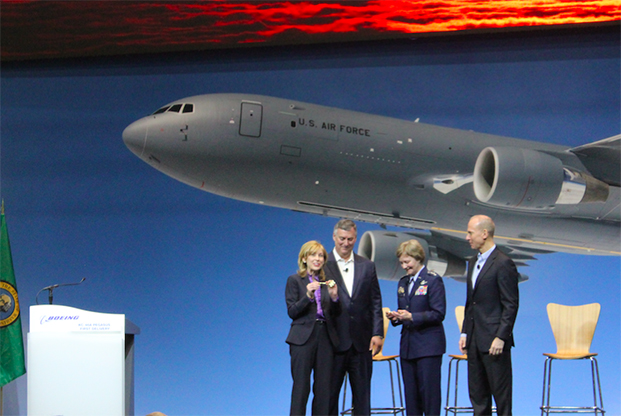
Boeing Defense CEO Leanne Caret presents a "key" to the first KC-46 delivered to the Air Force to Air Mobility Command boss Gen. Maryanne Miller during a ceremony Thursday at Boeing's production facility in Everett, Wash. Staff photo by Brian Everstine
EVERETT, Wash.—Boeing on Thursday handed the keys over to two KC-46s—one more than originally planned—during a ceremony at the company’s manufacturing facility here, before the aircraft make their maiden flight to their first operating base on Friday.
Thursday’s ceremony took place almost eight years after Boeing was awarded the contract for the next-generation tanker, two years after the original scheduled delivery, and about two weeks after the Air Force accepted the first KC-46 delivery.
“Our airmen are excited about flying the KC-46, and our mobility enterprise is ready,” Air Mobility Command boss Gen. Maryanne Miller said during a ceremony alongside Boeing officials. “Today we are adding another arrow in our quiver of mobility. …. We’re excited, we can’t wait to get this airplane to McConnell and we can’t wait to get after it.”
“We have 1,000 flying hours, 4,000 refuelings,” Air Force Secretary Heather Wilson said after the ceremony on Thursday. “We’re ready to take the next step, which is to get it in the hands of the airmen and to start operational test.”
Hundreds of Boeing employees crowded around a KC-46 production floor, with representatives from both KC-46 production and the commercial 767 line, which provided the base for the aircraft.
“Our audience today reflects how important it is to those in the earliest days who had the vision and to those here today who delivered,” Boeing Defense CEO Leanne Caret said at the ceremony.
Friday’s flight of two KC-46s to McConnell AFB, Kan., marks the first time the tankers will be delivered to the Air Force, and Boeing officials expect deliveries to ramp up through the year. Mike Gibbons, Boeing KC-46 vice president, said the first four KC-46s will be delivered to McConnell in the near future, with four to follow to Altus AFB, Okla., beginning next month. The goal is to deliver 36 aircraft this year. There are 52 aircraft on contract, with about a dozen in the final stages of production, Gibbons said.
The Air Force accepted delivery of the aircraft even though there are known deficiencies with the boom operator’s remote vision system, which Boeing is paying to fix, and an issue with the boom itself, which the Air Force will cover. The service is withholding up to $28 million per aircraft until deficiencies are corrected, and Boeing can receive those funds later if corrections are made in a timely manner, according to the Air Force.
Under certain circumstances, the boom operator’s view of refueling could be impaired, for example, if the sun hits the camera at a certain angle. Like a car’s backup camera, the view could be distorted by glare. Additionally, boom operators in testing couldn’t tell at times if the boom was scraping a receiving aircraft.
The system is currently safe and useful “as it is,” with some workarounds, Wilson said. For example, crews will not refuel if they are flying directly away from the sun to avoid glare issues. For the long term, Boeing is making software and hardware changes to address this issue, Gibbons said. The company is spending the early part of this year focusing on development to address the problem.
For the boom itself, there was an issue—specifically with an A-10 that was attempting to disconnect—because the Warthog is much lighter and flies slower than other aircraft. While Boeing’s design does meet the requirement put forth by the service, this issue requires a new program requirement change—the first for the KC-46 program, Wilson said. The Air Force will design a new part, an actuator, to address the problem.
